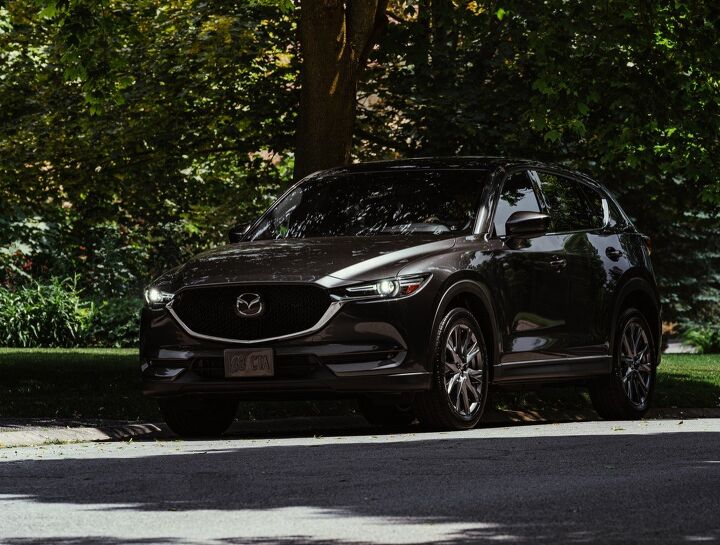The Mazda CX-5 Diesel Is Still AWOL
When it was rumors and innuendo, when it was delayed, when it was confirmed but unattainable, when it was launched, when it was actually under the hood of a vehicle we could drive on this continent, we’ve covered the story of Mazda’s diesel engine.
It’s a 2.2-liter turbocharged four-cylinder with a measly 168 horsepower but a stirring 290 lb-ft of stump-pulling torque. It resides not in the Mazda 6 for which it was originally intended but rather the highly acclaimed Mazda CX-5. It’s available only in the CX-5’s top-spec Signature trim, and only then at a $4,110 premium that drives the price up to an eye-watering $41,000. Its fuel economy gains are so minimal that the economic case for the CX-5 diesel is nonexistent.
And after one model year and just enough demand to help (in some small way) propel the CX-5 to yet another record sales year, the Mazda CX-5 diesel is missing. Truant. Unaccounted for.
Moreover, there’s no timetable for the CX-5 diesel’s return.
It doesn’t take a deep dive to discover that Mazda’s gone strangely silent on the subject of the diesel CX-5 in model year 2020. On both sides of the 49th parallel, on both the Build and Price sections of MazdaUSA.com and Mazda.ca, the 2.2-liter is no longer displayed as an option on the Signature trim. Likewise, turn to specifications pages and the 2020 CX-5 is listed with two engine configurations: the standard 187-horsepower 2.5-liter four-cylinder and the 250-horsepower turbocharged variant. (Don’t even get us started on Skyactiv-X timelines.)
Mind you, the Skyactiv-D powerplant earns its own independent vehicle listing as a 2019 model. Cars.com lists 22 such vehicles in stock in the United States. But in the world of the 2020 CX-5, which would be just the second model year in history for the Skyactiv-D, no such vehicle exists. There’s no Coming Soon; no Sign Up For Updates; no discussion of combined fuel economy up to 29 mpg.
Although we’re now deep into the first quarter of 2020, Mazda’s brand communications senior manager Drew Cary says there is “no update yet on the diesel for the 20MY,” but Mazda did clarify that the brand “recently received certification for both CX-5 and Mazda6.” In further discussion, Cary mentioned that, “Mazda hasn’t confirmed if they will be sold in the 2020 model year.”
Despite the apparent lack of certainty surrounding the CX-5 Skyactiv-D, Mazda confirmed that if the company does bring the diesel back to market, and if that process includes introducing it in the 6 midsize sedan, it would be the first iteration of the current-generation 6 to include all-wheel drive.
But will the small, independent, Japanese automaker even bother? Even without a diesel, the CX-5 is Mazda’s crown jewel. Through the first one-sixth of 2020, 53 percent of Mazda’s U.S. sales volume has been produced by the CX-5, sales of which jumped 14 percent, year-over-year. On the flip side, investing in the Mazda 6 midsize sedan may well be a fool’s errand. Only 21,524 6s were sold in the U.S. last year, the fourth consecutive year of decline for the 6 and a 63-percent drop since 2015.
Initial intentions to generate 10 percent of CX-5 sales volume fell by the wayside when the diesel’s official fuel economy ratings made it only slightly more efficient than the 2.5-liter CX-5, when it didn’t offer as much torque as the 2.5-liter turbo, and when Mazda paired the engine exclusively with the loftiest trim level. Incentives soared as demand failed to materialize.
If given another shot in 2020, is there any reason to believe the outcome will be different this year than it was last year? And given the fact that Mazda sales are finally on a positive trajectory, climbing 18 percent in 2020 so far thanks in large part to the addition of the new CX-30, might Mazda be wise to just forget its diesel losses?
[Images: Mazda]
Timothy Cain is a contributing analyst at The Truth About Cars and Driving.ca and the founder and former editor of GoodCarBadCar.net. Follow on Twitter @timcaincars and Instagram.
More by Timothy Cain
Latest Car Reviews
Read moreLatest Product Reviews
Read moreRecent Comments
- Bd2 Dark Brandon is doing a great job for the US. I hope he can run for a third term.
- Dave M. My hipster daughter is greatly into it. We watched the race together this weekend. It was interesting but I'm not devoted to it like she is. She'll be at the Austin race in October.
- Bd2 If I had time to watch other people driving, then I would go for LMP.
- Steve Biro There are 24 races on this year’s F1 schedule. And I guarantee you no more than two will be reasonably exciting, Meanwhile, F1’s reception for Andretti reveals the dark underbelly of the sport. I have followed F1 since the 1960s and, frankly, I am running out of interest. I’ll catch a race if it’s convenient but won’t bother DVRing them.
- YellowDuck Been watching since the 80s, seriously since the 90s once we had reliable TV coverage. I'm in Canada though. Hey, and don't forget that the Interlagos race is also in a convenient time zone, as is Mexico. So that's 5 races in the Americas. Absolutely love it, but it takes a bit more interest in the technical / strategic side of things to really appreciate it. It's not just going fast in circles until someone crashes into someone else, while drunk people watch. The US can be proud of what it has contributed - Austin is one of the best tracks on the calendar, Vegas turned out to be much better than anyone could have hoped, and even Miami - a real Indy car-style track - produced a good race this year.




































Comments
Join the conversation
Imagine having to support the few diesels they actually did sell. Then imagine the awful trade-in poison they will be to their owners and the used-car dealers who take them off their hands.
I wish modern Mazduh was AWOL - over priced vehicles with fake luxury. A brand truly in search of a real reputation - they put on aires for no reason.